In the first part of ‘BIM on the construction site’ series, we got to know the first two steps required to implement BIM technology in a construction company. It included familiarization with the topic and your actual needs as well as the decision concerning the first pilot project. In the following post, we will focus on software selection and people, who are the most important part of every organization. Enjoy your reading!
BIM on construction site - the whole serie in 10 points:
- Identify the subject and your needs. (part 1)
- Execute the pilot project. (part 1)
- Choose the software. (this article)
- Take care of people. (this article)
- Make clear responsibilities.
- Learn from the mistakes of others.
- Create necessary documents.
- Sign well-thought contracts.
- Engage all relevant parties.
- Decide and be consequent.
BIM in construction company and on site - Part 2.
List Of Contents
3. Choose the software.
Choosing the right software is difficult. Each program has its pros and cons, even though software suppliers assure us that they can solve any problem. Also, contractors are, to some extent, dependent on the system used by the designer. It would be great to have a common system to prevent data loss while transferring files, but on the other hand, different design offices use different programs. Another issue is the client’s requirements and the project type, which we should always approach individually.
A. Software selection assumptions.
When choosing software, we have to consider the following aspects:
- Client’s requirements, otherwise known as Client Information Requirements, being an equivalent to Employer’s Information Requirements (EIR), see also point 11 in our previous article about BIM terms.
The minimum that we have to meet are the investor’s requirements. At the moment every client has his own requirements, and usually we need to approach each project individually. In Norway, for instance, Nye Veier, the state organization responsible for highway construction, has very high requirements. They demand to use BIM Level III on their projects (you can read about BIM Level III here), which means that ‘everything’ should be placed in one model – including technical documentation of each individual element or health and safety. Another public infrastructure investor, Statens vegvesen, is in the initial phase of introducing BIM requirements to its projects, which are not so excessive at the moment.
Internal assumptions and ambitions for BIM in our company. Such assumptions and ambitions can be on the same level or higher than the client’s requirements. It is worth considering what we wish to achieve when it comes to BIM on our project. Do we just aim to meet the client’s requirements and deliver the project at the lowest cost, or do we wish to invest in the organization’s development and set ourselves a higher bar? It often happens that the investor does not have any requirements and wants the project to be executed at the lowest possible cost with minimum quality demands. Even in this situation, we strongly encourage you to introduce BIM on the construction site and test it in order to develop your company, having in mind the on-going change on the construction market.
Project type – depending on whether it is a large several kilometer-long infrastructure project or an office building, our needs will be different. Different software will work on different types of projects, so that we have to choose the one that will meet our requirements to the greatest extent.
Software features – we should ask ourselves a question what do we need – maybe only a ‘viewer’, which is a program allowing us to open a file, for example, in .ifc format and read the data? Or perhaps we wish to edit and ‘enrich’ it with new elements, such as temporary constructions related to the technology of works? One of the solutions is to buy one software in several versions – for example construction workers who use BIM on a construction site do not need all the available features, unlike BIM manager or a person who prepares and plans works. You may read about different types of software and its capabilities in our previous article.
Budget and time to introduce BIM technology in our organization and project. At this point, we do not have to explain much – even if we work in Qatar or Dubai, we will always have certain amount of money to buy software as well as time to introduce it to the project, and we have to stick to them.
B. File and Document Management System.
Another important decision we will face, and which is directly related to software selection, is to establish a file and document management system. (We wrote about choosing Common Data Environment earlier, in this article). It applies both to communication inside and outside of our project. We need to provide access to the data and technical documentation to the different participants of the construction process:
Inside our organization – we have to provide access to documentation not only to people working on the construction site, but often also to those who are in the main office. On the construction site, we have to, among other things, take care of BIM kiosks. These are places equipped with a computer with software and a printer, often placed in a separate container, which may be used by the construction workers directly on site.
Design office – assuming it is a ‘design and build’ project. As we mentioned previously, designers usually have their own document management system. We can try to adapt to it, or demand using different solution for our project.
Investor – in this case, a lot depends on the ordering party’s requirements. However, due to the lack of typical drawing documentation, the investor must at least have access to the latest 3D models and the technical documentation.
Subcontractors – they do not receive traditional drawings, but 3D models. Based on such models, they must make an evaluation and tender the works. In the next step, their task is to develop a ‘execution’ version of the documentation, which they will use directly on the construction site. We need to determine how will we interact with the subcontractors and if they have the necessary software. Also we have to make sure if their staff will be able to find and read the information they need in a correct way.
Suppliers – it applies in particular to reinforcement and formwork. I have noticed from my own experience, that suppliers usually expect 2D drawings in .dwg format. However, the attitude in the industry is changing and .ifc files are more frequently accepted. Also, in the case of the suppliers, we have to ensure that all the time they have and work on the updated technical documentation.
It is worth mentioning that, unfortunately, there is no one correct answer how to solve the file and document management. It all depends on the investor’s and our own requirements and the project type. We will often have to use several different programs, intended for different tasks, from different suppliers. It is not a perfect solution, however, it is often necessary in order to provide access to current data for involved parties from various companies.
The file and document management on large projects is a topic for the separate article that we plan to write in the future.
An example of distribution of documentation tested in an early phase of a project.
C. Cost of software.
Since software purchase is a big investment, both in terms of budget and time, we need to have clearly defined requirements. When choosing the software, the following factors will affect its cost:
- Number of licenses. How many licenses do we need? How many people will use a given program?
- One-time license purchase. Some suppliers offer ‘lifetime’ license, plus an annual fee for technical support or updates.
- License for a certain time, for example, for a year, or duration of a project – let’s say 25 months, with the possibility to prolong it.
- License for one position or ‘floating’ license that can be used on different computers.
- Technical support during the license period. Do we want and need to pay more, but receive technical support during certain time?
- Is it required to provide a certain number of licenses to the investor? If so, is a viewer (mostly free) sufficient, or do we have to purchase a full software license?
- Tablets, mobile phones – can we open and install the software on these devices? Do we need a separate version of the program to be able to use BIM on the construction site?
D. Software testing and technical support.
The majority of software suppliers offer a 30-day free trial period. It is worth using it and testing before purchase, as it is good to check whether a given program meets our expectations and requirements. Also, with technical support in mind, the trial period can tell us a lot – is the supplier willing to help us? If there are any problems, will they act quickly? So before buying, we should test various types of software and distributors, and choose those we trust the most.
We should also think about courses. When negotiating prices, I encourage you to ask the suppliers if we can count on, for instance, one-day introductory course, technical support for a certain time, or help with installation. Question does not cost anything, and it can significantly improve the initial phase of work with a given program.
E. VR, AR and MR technologies.
VR (Virtual Reality), AR (Augmented Reality) and MR (Mixed Reality) technologies are increasingly being used on the construction site. When choosing software, it is worth checking which of them support the use of the above mentioned technologies. However, since VR, AR and MR are usually not a topic in the first phase of introducing BIM in the execution company, and since it is a vast topic, we will deal with it in a separate article. The use of such technologies at the construction site is shown in this movie made by Norwegian designer Øystein Ulvestad.
4. Take care of people.
People are the greatest value of any organization. The individuals create the company and influence its functioning. However, even the best personnel needs the right guidelines and well-presented strategy. We need the right person in the right position. By ‘the right person’ we mean someone open to the new technologies and self-development. It does not mean only young people – it all depends on an attitude. It seems that combining both experienced employees with junior engineers is a good solution. Younger people are usually eager to become more involved in BIM on the construction site, and can support those more experienced, who, in turn, can teach younger colleagues many practical things related to the construction itself.
A. New tasks and responsibilities.
New technologies make it necessary for employees, already with their previous tasks and responsibilities, to adapt to the changes and find themselves in a new reality. It involves the use of BIM technology at various project phases, including bidding, preparation of works and time schedule, financial management, contact with both the investor and other participants in the construction process, ordering materials, or the construction work itself.
This is how the reality changes for people working on a traditional positions in a construction company during the BIM era:
- Site manager and project manager – they have to work without ready-made drawings and bending lists. People in such a position should be able to operate the model, find and read the data they need.
- Design manager – is responsible for contacting designer and guaranteeing right quality digital design documentation. Such a person is also a link between the design office and the construction site. His task is to maintain a good level of communication, which is mostly carried out by using .ifc models. The design manager must also prepare well-written contract with the designer, including the execution of the project with the use of BIM technology.
- BIM manager/coordinator – it is usually a completely new position in an organization just introducing BIM. You can read about BIM coordinator and his roles here.
It is worth noting that BIM managers working on a construction site, in an execution company, will have different tasks from someone on the equivalent position in a design office. A great part of of the tasks includes the support of less experienced personnel in BIM technology as well as model and data management on the project.
Surveyor – for a long time, a person in this position has been using models, hence in this case surveyors will not notice any significant change. However, the use of BIM technology and working without drawings demands their greater involvement, particularly in the initial phase of the project. When employees are unsure about the data in the model, or whether taken dimensions are correct, they often ask surveyors to mark and check, for instance, construction points or fromwork. This fact is worth taking into account when bidding and assuming the number of surveyors required to conduct the project.
Planner, engineer working with the construction technology and time schedule – so far, in some cases, they have worked ‘separately’, on programs known only to themselves. They also need to learn how to operate the model, and in the case of work planning, how to add temporary structures to the 3D model. When it comes to the time schedule, it is necessary to use the model and understand all the subsequent phases of the construction. And ultimately, maybe in the future, how to combine BIM models with the time schedule, creating 4D.
- Quality engineer – there is no paper form of the quality documentation anymore. Now it is stored in ‘the cloud’. An employee working in this position is responsible for archiving it in the system or directly in the BIM model, assigning documents to the specific elements.
- Health and safety specialist – by using BIM technology, including visualization, such a person can notice possible risks and dangers and then pass them on in an accessible and understandable form to the employees. For this reason, they should learn about model orientation and presentation of different construction phases.
- Tender engineer – traditionally he used fixed spreadsheets, where he entered the values needed to prepare a tender of the project. In the age of BIM technology, the tenderer must use the models and know how to ‘extract’ the required data. In the long run, on the other hand, he should aim to combine a spreadsheet with a BIM model.
- Foreman and construction worker – a project without drawings is a big challenge for experienced construction workers, who are used to the way they work from before. Sometimes there is a fear that they may be opposed to something completely new, and they will eventually say ‘it is impossible to build without the drawings’. However, it is important to explain why we wish to use BIM technology on the construction site, what benefits it gives, and prove that it is the only approach all construction companies will follow. I have noticed that due to a good communication and appropriate training in the company, the workers are not opposed to the new technologies, but even have a positive attitude towards them.
- Project controller – it is a less obvious position on this list since the controller works mostly with financial matters. However, a person working in this position must know, among other things, how the data and documentation management system works or where to find the current status of the project.
B. Education of staff and employees.
Due to individual responsibilities, each staff member needs a different kind of BIM knowledge. For example, a surveyor does not need to know how to generate bending lists and a construction worker how to manage IFC files.
With the popularity that BIM is currently gaining, there are many different types of training and courses. Unfortunately, these are mostly ‘introductory’ showing, for instance, the possibilities of BIM technology at a basic level. Most of them are aimed at designers and involve working with a specific type of software. Unfortunately, there is still no course typical for a construction company, dealing with practical issues related to BIM technology on the construction site.
What can we do in this situation? Let’s consider the topic looking at the whole team and the strategy of BIM implementation in our organization, and then carry out the following actions:
Select key workers to introduce BIM technology in our company. This could be a BIM manager, a person responsible for BIM in the organization, or a design manager. Some organizations may have a separate position like ‘Head of BIM’ or ‘BIM Champion’, but here the names are not important. Ideally, we should select 2 or 3 people, whose task would be to reach a high level of knowledge through training, courses, conferences, and self-education.
The key workers, together with their supervisors, decide on the need to improve the competence of employees on particular positions, and what is more important – the way it should be done. Some employees should sign up for a course that gives them specific knowledge to become more effective, for example, in using a particular software. If there are more people interested in a given topic in your company, you may consider inviting external consultants. It will probably cost more, but the advantage is that we can adjust the training to our needs.
Use your own resources. Well, it turns out that we may carry many courses with the help of more experienced people from our own organization. For example, a BIM manager or design manager may give an introductory course in our company on ‘what is BIM and why we should use it’, ‘how to communicate on a project with BIM technology’, or more specific, like ‘generating bending lists on the construction site’.
Create a learning and self-development environment within our company. The example comes from the top – senior managers need to promote the use of BIM technology, and at the same time be interested in how it works. It is very important to clearly communicate to all employees why it was decided to introduce BIM and emphasize its advantages and challenges. And also explain that it is the only way into the future. There is no return to 2D drawings or paper documentation.
Summary of the second part of BIM in construction company and on site.
In the article, which is the continuation of ‘BIM on the construction site’ series, we have described issues concerning software selection and the importance of taking care of people who will work with the new technology. The decisions related to software and the strategy of increasing staff qualifications made at the initial phase of BIM implementation will influence the success or challenges of conducted projects later on.
Does your construction company implement BIM technology on the construction site? What software do you use? What are BIM requirements imposed on the project? Has your company adopted a staff and employee training strategy?
Tell us your experiences and share your comments below this article or write us on [email protected]!
Check out other articles about BIM in construction company and on site:

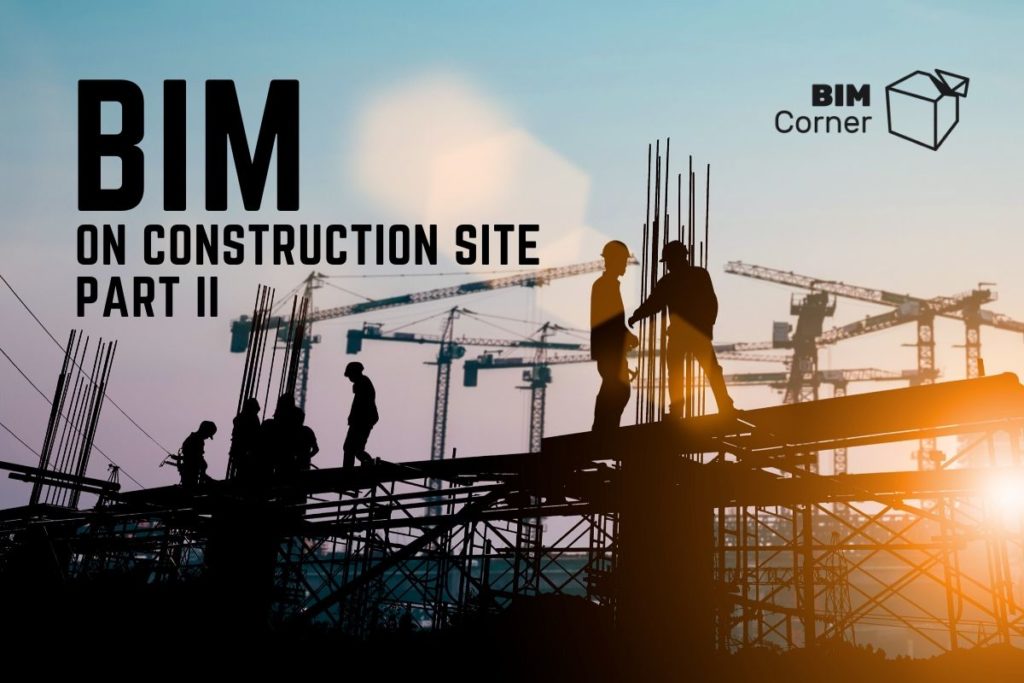
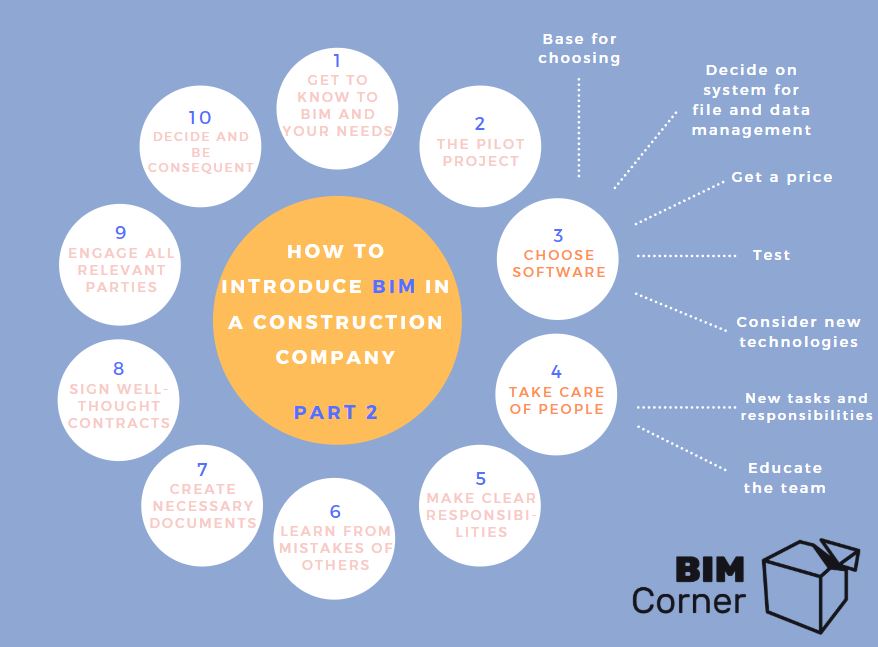
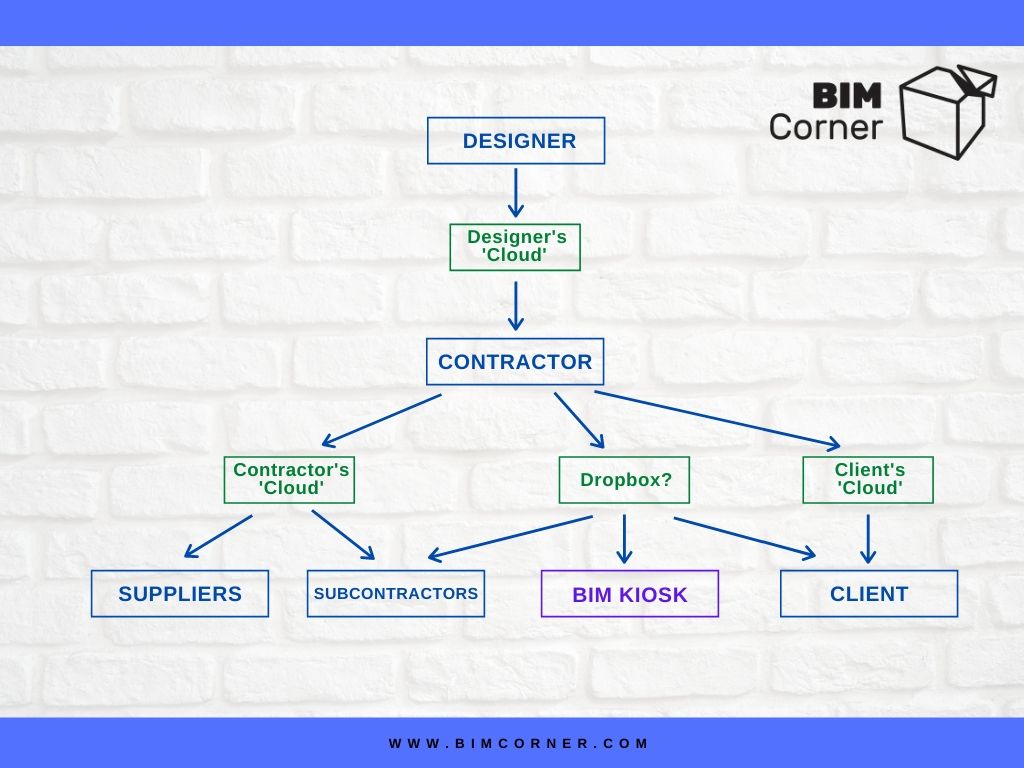

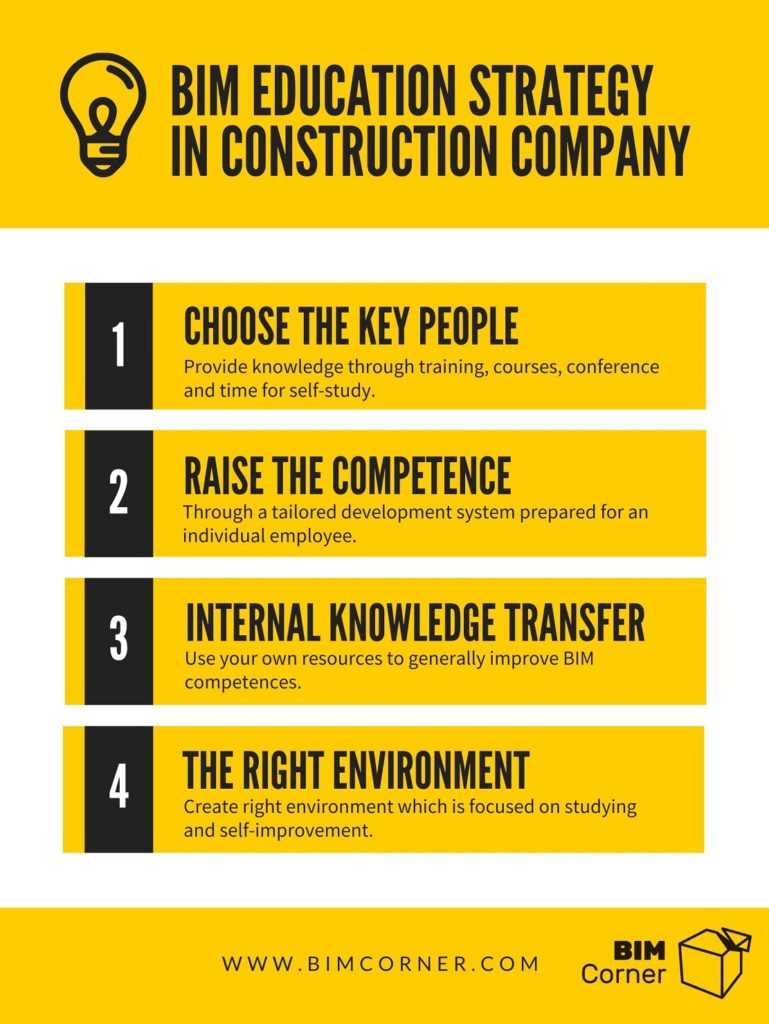





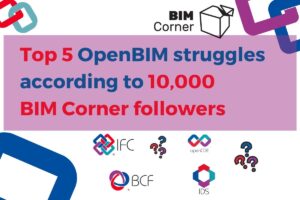

Could you please develop the information that you included in the diagramm “An example of distribution of documentation” (section 3B)? In my opinion it should be created in the way that there is one source of information with access for all involved in the project. Otherwise, how do we avoid discrepancies between, for example, Designer´s Cloud and Contractor’s Cloud? It would be great to understand better yor idea.
Hello Natalia!
Thank you for your comment, which is very relevant in this case. The ‘one source of information’ is a requirement while using BIM on ‘Level III’. I agree that it would be best to execute all projects in this way. The example which I showed was taken from a real project and is based on the following assumptions:
– In practice, especially on first projects on which companies want to introduce BIM, they usually prefer going gradually from 2D and traditional way of working to BIM ‘Level II’. (*BIM level II is described as ‘file based collaboration and library managment’).
– On many contracts there are still no requirements to use BIM on level III. One of the reasons is that the clients do not know what they actually need and are not capable to use all of that information even if they get it.
– On some contracts, the client requires use of their own database as a way of communication between the client and the contractor. This gives us one additional platform on which we need to mirror all of the information.
– Although many software suppliers will claim that they have solution for everything, using just one platform for whole project was not, until recently, possible. It was necessary to have some kind of mix of different programs.
Thank you again for your comment and I would be glad to hear from you if you have any more feedback!
Best regards,
Konrad Naborczyk from BIM Corner
Hi Konrad.
Thank you for your quick answer.
Yes, now I understand what you mean. I was happy when I found your blog because it lets to see some of a “naked truth” about BIM implementation. I am doing BIM Management course and it feels a little bit too academic to me. At the end of the day, when you try to confront all standards and definitions with reality, it looks like nothing works properly.
Maybe it is just my impression, but it seems like instead of becoming easy and controlled process it is getting more and more complicated. Especially in Architecture, where apart of change resistance, there is also a lot of “BIM is taking away my creativity” 🙂